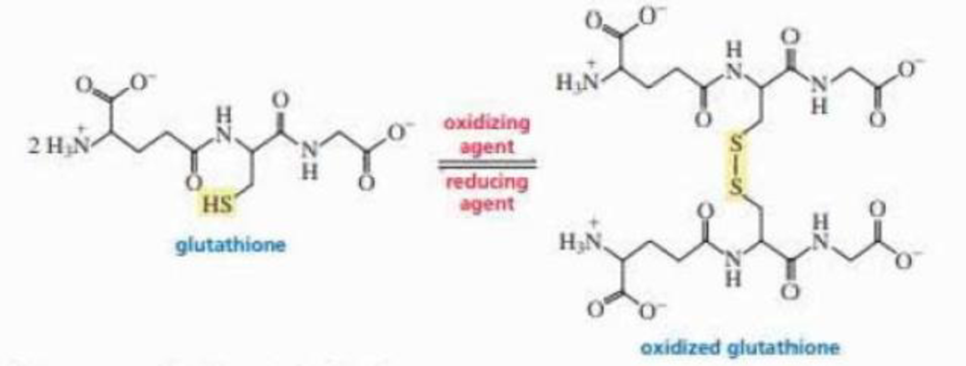
Glutathione is a tripeptide whose function is to destroy harmful oxidizing agents in the body. Oxidizing agents are thought to be responsible for some of the effects of aging and to play a causative role in cancer.
Glutathione removes oxidizing agents by reducing them. In the process, glutathione is oxidized, resulting in the formation of a disulfide bond between two glutathione molecules. An enzyme subsequently reduces the disulfide bond, returning glutathione to its original condition so it can react with another oxidizing agent.

a. What amino acids make up glutathione?
b. What is unusual about glutathione’s structure? (If you cannot answer this question, draw the structure you would expect for the tripeptide and compare your structure with the actual structure.)
Want to see the full answer?
Check out a sample textbook solution
Chapter 21 Solutions
Organic Chemistry (8th Edition)
- Explain by equations how organophosphate pesticides can harm humans.arrow_forwardCatalytic cracking is an industrial process used to convert high-molecular-weight hydrocarbons to low-molecular-weight hydrocarbons. A petroleum company has a huge supply of heating oil stored as straight-chain C17H36, and demand has picked up for shorter chain hydrocarbons to be used in formulating gasoline. The company uses catalytic cracking to create the shorter chains necessary for gasoline. If they produce two molecules in the cracking, and 1-octene is one of them, what is the formula of the other molecule produced? As part of your answer, draw the condensed structural formula of the 1-octene.arrow_forwardDigitalis is a preparation made from the dried seeds and leaves of the purple foxglove, Digitalis purpurea, a plant native to southern and central Europe and cultivated in the United States. The preparation is a mixture of several active components, including digitalin. Digitalis is used in medicine to increase the force of myocardial contraction and as a conduction depressant to decrease heart rate (the heart pumps more forcefully but less often).arrow_forward
- When ethylamine, a weak base (Kb=4.3104) , reacts with formic acid, a weak acid (Ka=1.8104) , the following reaction takes place: CH3CH2NH2(aq)+HCOOH(aq)CH3CH2NH3+(aq)+HCOO(aq) Calculate K for this reaction.arrow_forwardEstradiol is a female hormone with the following structure: How many chiral carbon atoms are in estradiol?arrow_forwardLipoic acid is required by many microorganisms for proper growth. As a disulfide, it functions in the living system by catalyzing certain oxidation reactions and is reduced in the process. Write the structure of the reduction product.arrow_forward
 Chemistry: An Atoms First ApproachChemistryISBN:9781305079243Author:Steven S. Zumdahl, Susan A. ZumdahlPublisher:Cengage Learning
Chemistry: An Atoms First ApproachChemistryISBN:9781305079243Author:Steven S. Zumdahl, Susan A. ZumdahlPublisher:Cengage Learning
 ChemistryChemistryISBN:9781305957404Author:Steven S. Zumdahl, Susan A. Zumdahl, Donald J. DeCostePublisher:Cengage Learning
ChemistryChemistryISBN:9781305957404Author:Steven S. Zumdahl, Susan A. Zumdahl, Donald J. DeCostePublisher:Cengage Learning Organic ChemistryChemistryISBN:9781305580350Author:William H. Brown, Brent L. Iverson, Eric Anslyn, Christopher S. FootePublisher:Cengage Learning
Organic ChemistryChemistryISBN:9781305580350Author:William H. Brown, Brent L. Iverson, Eric Anslyn, Christopher S. FootePublisher:Cengage Learning General Chemistry - Standalone book (MindTap Cour...ChemistryISBN:9781305580343Author:Steven D. Gammon, Ebbing, Darrell Ebbing, Steven D., Darrell; Gammon, Darrell Ebbing; Steven D. Gammon, Darrell D.; Gammon, Ebbing; Steven D. Gammon; DarrellPublisher:Cengage Learning
General Chemistry - Standalone book (MindTap Cour...ChemistryISBN:9781305580343Author:Steven D. Gammon, Ebbing, Darrell Ebbing, Steven D., Darrell; Gammon, Darrell Ebbing; Steven D. Gammon, Darrell D.; Gammon, Ebbing; Steven D. Gammon; DarrellPublisher:Cengage Learning Introductory Chemistry: An Active Learning Approa...ChemistryISBN:9781305079250Author:Mark S. Cracolice, Ed PetersPublisher:Cengage Learning
Introductory Chemistry: An Active Learning Approa...ChemistryISBN:9781305079250Author:Mark S. Cracolice, Ed PetersPublisher:Cengage Learning





